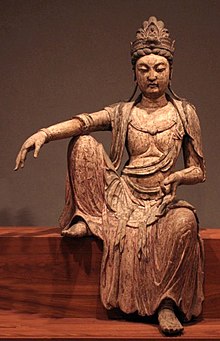

TYPE: Benign guardian goddess
ORIGIN: Taoist (Chinese)
KNOWN PERIOD OF WORSHIP: Circa CE 100, though in various forms, until present
SYNONYMS: Guan Yin; Kwannon (Japanese)
CENTER(S) OF CULT: Throughout Chinese culture
ART REFERENCES: Paintings and sculptures
LITERARY SOURCES: Various philosophic and religious texts, mostly inadequately researched and untranslated.
INFORMATION: An essentially foreign deity, derived from the Buddhist god Avalokitesvara, and therefore probably of Indian origin. Introduced into China as a male deity until circa CE 600 when the transition to a goddess began; it was completed by circa CE 1100. Although accepted into Taoism, in contrast to all other Chinese deities, she is not provided with the normal offerings of food and wine.
An alternative tradition places her in a mortal existence as the princess Miao SHan who committed suicide by strangling herself and was subsequently taken by the Buddha to an island, P'u T'o, where she spent nine years perfecting herself.
Kuan Yin enjoys a major popularity as a pure and benevolent spirit whose influence has eclipsed that of the historical Buddha incarnation, Sakyamuni, in China. Her name is invoked if danger threatens and she has strong fertility connotations—newly married couples pray to her for children.
Several other Chinese goddesses are considered by some authors to be manifestations of Kuan Yin. She frequently shares sanctuaries with the queen of heaven, Tin Hau, and has taken over part of her area of influence. She is thus titled Goddess of the Southern Sea, which is technically an accolade due to Tin Hau.
Kuan Yin is depicted seated upon a lotus with attributes including a vase filled with the dew of compassion adn a willow branch. Her attendant Lung Nu may stand behind her with other objects, including a peacock-like bird, pearls and a rosary.